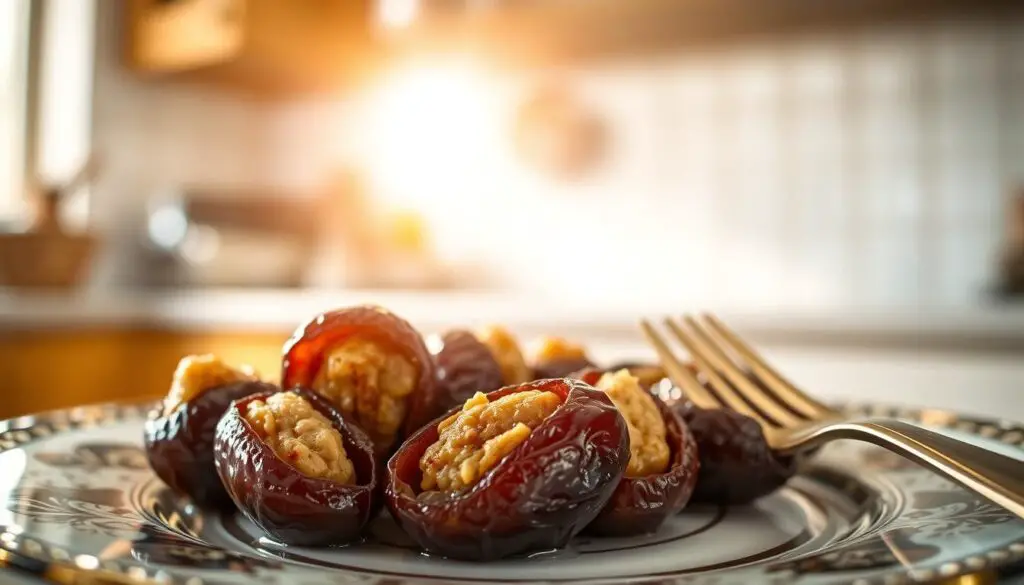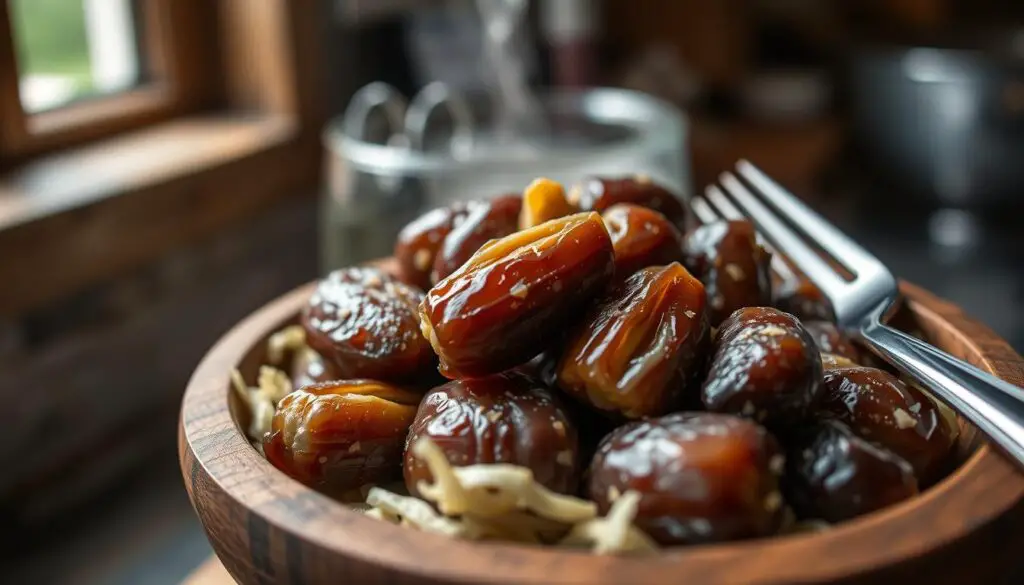Softening dates is an essential step in the culinary world, especially when it comes to enhancing your date recipes. The texture of dates plays a critical role in how they integrate into dishes, particularly in stuffing. When learning how to soften dates, it’s important to understand that the right techniques not only preserve their natural sweetness but also enhance the overall flavor profile of your meals. By effectively softening dates, you can elevate your dishes, whether you are preparing appetizers or desserts that feature date stuffing techniques.
Key Takeaways
- Softening dates is crucial for optimal flavor and texture in recipes.
- Various techniques exist to soften dates effectively.
- Properly softened dates enhance the overall quality of date stuffing.
- The right type of dates can make a difference in stuffing applications.
- Understanding how to soften dates can expand your culinary skills.
Introduction to Softening Dates
Softening dates holds significant importance in culinary applications, especially when they are overly dry or hard. The process of softening not only enhances their taste but also improves their usability in various recipes. Properly softened dates help achieve a more uniform texture, allowing for seamless integration into stuffing or other fillings.
By employing the right softening techniques, chefs and home cooks can maximize the flavor and texture of dates. Culinary softening methods, such as soaking or steaming, can rejuvenate these nutritious fruits, making them more palatable and easier to work with.
Understanding the importance of softening dates transforms the way they are utilized in dishes. A well-prepared date not only enhances the overall flavor profile of a dish but also contributes essential nutrients, making it a valuable ingredient in a variety of culinary creations.
Why Use Dates for Stuffing?
Dates offer unique advantages that make them a popular choice for date stuffing. Their natural sweetness, combined with a delightful chewiness, enhances both flavor and texture in various dishes. When exploring the uses of dates in cooking, the versatility of this fruit shines through. Incorporating dates into stuffing not only elevates the taste but also introduces notable nutritional benefits.
One significant benefit of dates is their high fiber content, which aids digestion and helps maintain a healthy gut. Additionally, these fruits are rich in essential vitamins and minerals, contributing to overall well-being. Their complex flavors can add depth to savory stuffing recipes, making the dish more satisfying.
When making stuffing, dates can be paired with a variety of ingredients. From nuts and grains to spices and herbs, the options are virtually limitless. This adaptability showcases the diverse uses of dates in cooking, whether in a traditional holiday meal or a modern culinary creation.
Incorporating dates into stuffing creates a unique flavor profile that appeals to a wide range of palates. Whether using them as a main ingredient or an accent, the presence of dates can transform a simple recipe into a memorable dish that guests will cherish.

| Benefit | Description |
|---|---|
| Natural Sweetness | Adds a unique flavor without refined sugars |
| Nutritional Value | Rich in fiber, vitamins, and minerals |
| Versatility | Works well with both sweet and savory dishes |
| Texture | Provides chewiness that enhances the eating experience |
| Flavor Depth | Contributes a rich, caramel-like flavor |
Health Benefits of Dates
Dates are not only delicious but also packed with numerous health benefits. The nutritional value of dates includes a rich supply of essential vitamins and minerals. These fruits are a great source of dietary fiber, which aids in digestion and supports gut health.
One of the remarkable aspects of dates is their high natural sugar content. This makes them an excellent alternative to processed sugars in recipes. The health benefits of eating dates extend beyond just sweetness; they provide quick energy, making them ideal for athletes and those seeking a healthy snack.
When looking at dates as superfoods, they shine with their content of important nutrients like potassium, magnesium, and vitamin B6. These compounds contribute to heart health, help regulate blood pressure, and promote overall well-being. Incorporating dates into your daily diet can enhance your nutritional intake significantly.
| Nutritional Component | Amount per 100g |
|---|---|
| Total Calories | 277 kcal |
| Carbohydrates | 75 g |
| Fiber | 7 g |
| Protein | 2 g |
| Fat | 0.15 g |
| Potassium | 696 mg |
| Magnesium | 54 mg |
| Vitamin B6 | 0.2 mg |
Incorporating dates into your meals is an excellent way to enjoy their numerous health advantages while adding natural sweetness to dishes. Their versatility makes them suitable for both savory and sweet recipes, ensuring you can reap the benefits in various culinary creations.
How do you soften dates for stuffing?
Softening dates can significantly enhance their texture and make them ideal for stuffing. Several techniques for softening dates are commonly used, allowing cooks to choose the method that best suits their needs and preferences. Understanding the types of dates available, such as Medjool dates and Deglet Noor dates, can help in selecting the perfect variety for your culinary creations.
Common Techniques for Softening Dates
There are various techniques for softening dates that can cater to different preferences and time constraints:
- Soaking: Immersing dates in warm water for approximately 10-15 minutes can enhance their softness and pliability.
- Microwaving: This method involves placing dates in a microwave-safe bowl with a small amount of water, microwaving them for about 10-20 seconds until softened.
- Steaming: Utilizing a steamer basket over boiling water for a few minutes allows the dates to absorb steam, resulting in a tender texture.
Choosing the right technique can save time and improve the overall outcome in recipes, making it easier to prepare stuffed dates without compromising flavor or texture.
Choosing the Right Type of Dates
The choice of dates can make a significant difference in the final dish. Medjool dates are renowned for their rich, caramel-like flavor and soft texture, making them perfect for stuffing with nuts or other delightful fillings. On the other hand, Deglet Noor dates are firmer and have a slightly more chewy texture, providing a different mouthfeel that may work well in various combinations. Understanding the unique characteristics of these types of dates allows for better recipe development and caters to diverse palates.
For more ideas on stuffing dates with nuts like walnuts or pecans, check out this recipe. You can also explore additional recipes, such as zucchini biscuits, which can complement your stuffed dates well by visiting this link.

How Soaking Affects Texture
Soaking dates can dramatically alter their texture, making them softer and more pliable. The effects of soaking primarily stem from water absorption. When dates soak in liquid, their fibers begin to absorb moisture, leading to significant date texture improvement. This process not only enhances the dates’ consistency but also makes them more suitable for various culinary applications.
Scientific studies reveal that when dates soak, their internal structure changes significantly. The cellular walls soften, allowing the dates to become juicier and less dense. As a result, the texture becomes ideal for stuffing or incorporating into dishes where a tender consistency is desired.
The table below illustrates the differences in texture before and after soaking dates:
| Condition | Texture Description |
|---|---|
| Before Soaking | Firm, dense, and chewy |
| After Soaking | Soft, moist, and easily manipulated |
As demonstrated, the process of soaking dates yields remarkable texture enhancement. Incorporating this technique in cooking can lead to a more enjoyable dining experience, making recipes rich in flavor and easier to handle.
Microwave Method for Quick Softening
Softening dates can be a simple and quick process using a microwave, one of the most effective quick methods for softening dates. This technique not only saves time but also helps retain the flavor and texture of the dates, making them ideal for stuffing or adding to recipes. Follow this step-by-step guide to microwave softening dates efficiently.
Step-by-Step Guide to Microwaving Dates
- Prepare Dates: Remove the pits from the dates and chop them into halves or quarters for faster softening.
- Place in a Bowl: Put the chopped dates in a microwave-safe bowl and add a few tablespoons of water to create steam during cooking.
- Cover the Bowl: Use a microwave-safe lid or plate to cover the bowl, trapping the steam inside which aids in softening.
- Microwave: Heat the dates on high for about 15-30 seconds. Check the consistency and stir the dates halfway through to ensure even heating.
- Test for Softness: After microwaving, check if the dates have reached the desired softness. If not, microwave in additional 10-second intervals until soft.
- Cool Before Use: Allow the dates to cool down briefly before incorporating them into your dishes to prevent any burns.
These cooking tips will make your experience smoother when dealing with dates, making this one of the most practical techniques available. For those looking for quick methods for softening dates, using the microwave stands out as a favorable option.
| Microwave Time (Seconds) | Softness Level | Recommended Usage |
|---|---|---|
| 15 | Slightly Soft | For blending into smoothies or batters |
| 20 | Moderately Soft | For stuffing or baking applications |
| 30+ | Very Soft | For making date paste or energy balls |
Using Hot Water for Softening
Hot water soaking dates is a preferred method for those looking to enhance the texture and flavor of their dried fruits. This technique involves immersing dates in warm water for a short period, which actively helps in softening their naturally tough exterior. Many find this approach among the most effective softening methods, particularly when preparing dates for stuffing.
Benefits of Hot Water Soaking
Utilizing hot water for softening dates provides several notable advantages:
- Improved Texture: Soaking in hot water allows the dates to absorb moisture, making them plumper and easier to work with.
- Flavor Enhancement: The warm water helps unlock the natural sugars in the dates, resulting in a sweeter taste profile.
- Quick Process: This technique is fast, requiring only 10 to 15 minutes to achieve ideal softness.
- Nutritional Preservation: Hot water soaking dates preserves the vitamins and minerals within, maintaining their healthy qualities.
For those who prefer a more gentle approach, the benefits of steaming dates can be equally effective. Regardless of method, understanding the ideal soaking time and temperature is crucial for optimal results.
For tips on using homemade ingredients like soft sandwich bread in conjunction with dates, refer to this useful guide on preparing bread.
Alternative Softening Techniques
When exploring alternative methods for softening dates, several creative ways emerge that can enhance your food preparation techniques. While soaking or microwaving are common practices, other methods may suit different preferences and kitchen setups.
One efficient technique involves steam cooking dates. This method allows the fruit to absorb moisture quickly. Placing dates in a steaming basket over boiling water for a few minutes renders them deliciously soft without compromising flavor. This approach yields a fresh taste while preserving nutrients.
Another option is roasting dates in an oven. Preheat the oven to a low temperature and spread the dates on a baking sheet. A brief period in the oven can create a warm, gooey texture that adds depth to your recipes. It pays to keep an eye on them to avoid overcooking.

For those seeking convenience, using a food processor can also be a viable choice. Pulsing dates with a bit of water results in a smooth mixture that’s perfect for fillings. This method avoids the need for soaking and effectively softens dates for immediate use.
Combining these creative ways to soften dates enhances not just the texture but also the flavor profiles in your dishes. Evaluating the efficiency, pros, and cons of each technique can lead to discovering the best methods tailored to individual culinary needs.
Conclusion
In summary of softening dates, it’s clear that preparing these delicious fruits properly can greatly enhance their texture and flavor when used in stuffing. By utilizing various techniques discussed, from soaking in hot water to quick methods like microwaving, you can achieve the ideal consistency that complements your culinary creations. Whether you prefer the natural sweetness of Medjool or the chewy texture of Deglet Noor, the best practices for using dates in recipes can truly elevate your dishes.
As you explore the different softening methods, consider how they might work with various recipes. Experimenting with these techniques can lead to richer flavors and a more enjoyable dining experience. The closing thoughts on date preparation emphasize the versatility of dates, making them a superb choice for not only stuffing but also a variety of healthy dishes. Let your creativity shine as you incorporate dates into your meals!

Can you be more specific about the content of your article? After reading it, I still have some doubts. Hope you can help me.